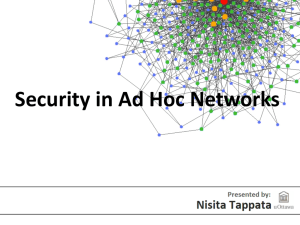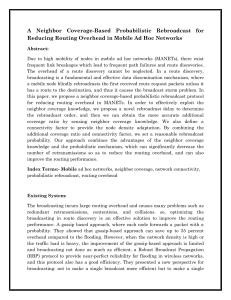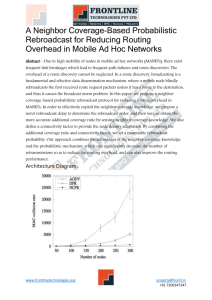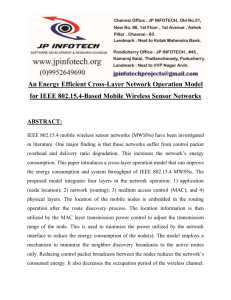www.ijecs.in International Journal Of Engineering And Computer Science ISSN:2319-7242
advertisement
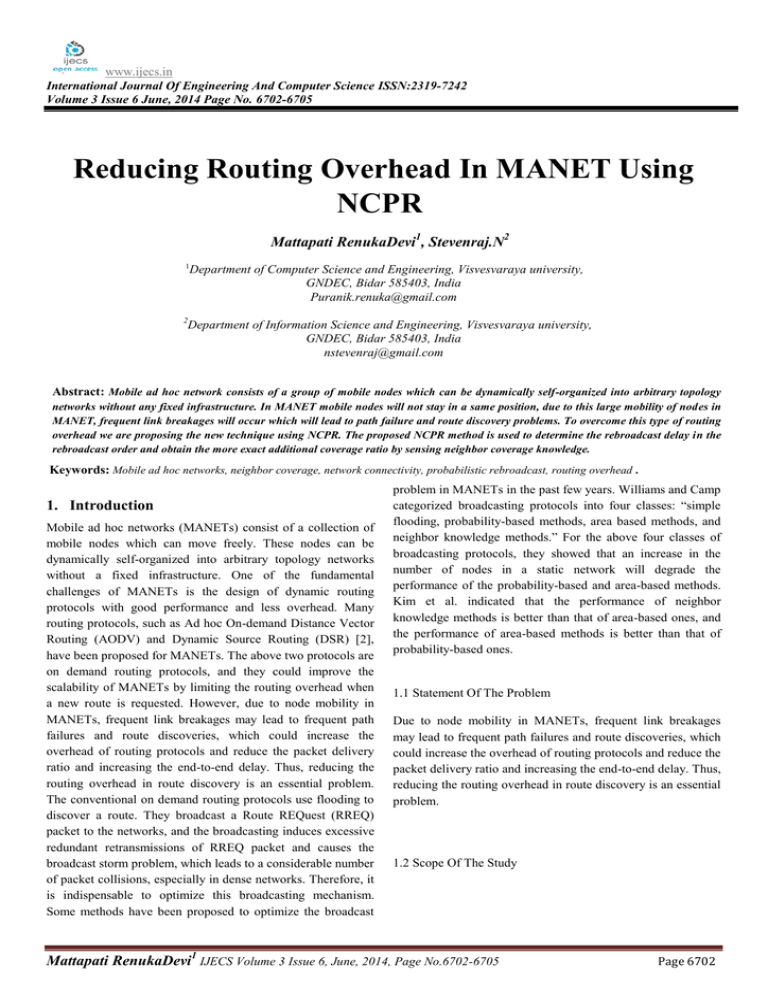
www.ijecs.in
International Journal Of Engineering And Computer Science ISSN:2319-7242
Volume 3 Issue 6 June, 2014 Page No. 6702-6705
Reducing Routing Overhead In MANET Using
NCPR
Mattapati RenukaDevi1, Stevenraj.N2
1
Department of Computer Science and Engineering, Visvesvaraya university,
GNDEC, Bidar 585403, India
Puranik.renuka@gmail.com
2
Department of Information Science and Engineering, Visvesvaraya university,
GNDEC, Bidar 585403, India
nstevenraj@gmail.com
Abstract: Mobile ad hoc network consists of a group of mobile nodes which can be dynamically self-organized into arbitrary topology
networks without any fixed infrastructure. In MANET mobile nodes will not stay in a same position, due to this large mobility of nodes in
MANET, frequent link breakages will occur which will lead to path failure and route discovery problems. To overcome this type of routing
overhead we are proposing the new technique using NCPR. The proposed NCPR method is used to determine the rebroadcast delay in the
rebroadcast order and obtain the more exact additional coverage ratio by sensing neighbor coverage knowledge.
Keywords: Mobile ad hoc networks, neighbor coverage, network connectivity, probabilistic rebroadcast, routing overhead .
1. Introduction
Mobile ad hoc networks (MANETs) consist of a collection of
mobile nodes which can move freely. These nodes can be
dynamically self-organized into arbitrary topology networks
without a fixed infrastructure. One of the fundamental
challenges of MANETs is the design of dynamic routing
protocols with good performance and less overhead. Many
routing protocols, such as Ad hoc On-demand Distance Vector
Routing (AODV) and Dynamic Source Routing (DSR) [2],
have been proposed for MANETs. The above two protocols are
on demand routing protocols, and they could improve the
scalability of MANETs by limiting the routing overhead when
a new route is requested. However, due to node mobility in
MANETs, frequent link breakages may lead to frequent path
failures and route discoveries, which could increase the
overhead of routing protocols and reduce the packet delivery
ratio and increasing the end-to-end delay. Thus, reducing the
routing overhead in route discovery is an essential problem.
The conventional on demand routing protocols use flooding to
discover a route. They broadcast a Route REQuest (RREQ)
packet to the networks, and the broadcasting induces excessive
redundant retransmissions of RREQ packet and causes the
broadcast storm problem, which leads to a considerable number
of packet collisions, especially in dense networks. Therefore, it
is indispensable to optimize this broadcasting mechanism.
Some methods have been proposed to optimize the broadcast
problem in MANETs in the past few years. Williams and Camp
categorized broadcasting protocols into four classes: “simple
flooding, probability-based methods, area based methods, and
neighbor knowledge methods.” For the above four classes of
broadcasting protocols, they showed that an increase in the
number of nodes in a static network will degrade the
performance of the probability-based and area-based methods.
Kim et al. indicated that the performance of neighbor
knowledge methods is better than that of area-based ones, and
the performance of area-based methods is better than that of
probability-based ones.
1.1 Statement Of The Problem
Due to node mobility in MANETs, frequent link breakages
may lead to frequent path failures and route discoveries, which
could increase the overhead of routing protocols and reduce the
packet delivery ratio and increasing the end-to-end delay. Thus,
reducing the routing overhead in route discovery is an essential
problem.
1.2 Scope Of The Study
Mattapati RenukaDevi1 IJECS Volume 3 Issue 6, June, 2014, Page No.6702-6705
Page 6702
Since limiting the number of rebroadcasts can effectively
optimize the broadcasting, and the neighbor knowledge
methods perform better than the area-based ones and the
probability-based ones, then we propose a neighbor coveragebased probabilistic rebroadcast (NCPR) protocol. Therefore, 1)
in order to effectively exploit the neighbor coverage
knowledge, we need a novel rebroadcast delay to determine the
rebroadcast order, and then we can obtain a more accurate
additional coverage ratio; 2) in order to keep the network
connectivity and reduce the redundant retransmissions, we need
a metric named connectivity factor to determine how many
neighbors should receive the RREQ packet. After that, by
combining the additional coverage ratio and the connectivity
factor, we introduce a rebroadcast probability, which can be
used to reduce the number of rebroadcasts of the RREQ packet,
to improve the routing performance.
The N(s) and N(ni) are the neighbors sets of node. s is sends an
RREQ packet to node ni. According to Eq.(1), The broadcast
characteristics of an RREQ packet, node ni can receive the
duplicate RREQ packets from its neighbors. Node ni could
further adjust the U(ni) through the neighbor knowledge. In
order to sufficiently exploit the neighbor knowledge and avoid
channel collisions, each node should set a rebroadcast delay.
The choice of a proper delay is the key to success for the
proposed protocol because the scheme used to determine the
delay time affects the dissemination of neighbor coverage
knowledge. When a neighbor receives an RREQ packet, it
could calculate the rebroadcast delay according to the neighbor
list in the RREQ packet and its own neighbor list. The
rebroadcast delay Td(ni) of node ni is defined as follows:
Tp(ni) = 1 − |N(s)∩N(ni)|
|N(s)|
Td (ni) = MaxDelay × Tp(ni) ,
(2)
2. Literature Survey
Xin Ming Zhang et al [1] show that the probabilistic
rebroadcast protocol based on neighbor coverage to reduce the
routing overhead in MANETs. C. Perkins et al [2] Shows that
the Ad hoc On-Demand Distance Vector (AODV) routing
protocol is intended for use by mobile nodes in an ad hoc
network. H AlAmri et al [3] shows that new routing protocol
for Ad hoc networks, called on demand Tree-based Routing
Protocol (OTRP). Z. J. Haas et al [4] many ad hoc routing
protocols are based on some variant of flooding. Despite
various optimizations of flooding, many routing messages are
propagated unnecessarily. B Williams & T Camp [5] had
discussed the Network wide broadcasting in Mobile Ad Hoc
Networks provides important control and route establishment
functionality for a number of unicast and multicast protocols.
Where Tp (ni) is the delay ratio of node ni, and MaxDelay is a
small constant delay. | · | is the number
of elements in a set. The above rebroadcast delay is defined
reasons: First, the delay time is used to determine the node
transmission order. To sufficiently exploit the neighbor
coverage knowledge. The
Eq. (2) is, node nk has the lowest delay. Once node nk
rebroadcasts the RREQ packet, here more nodes to receive it,
because node nk has the largest number of common neighbors.
Then there are more nodes which can exploit the neighbor
knowledge to adjust their UCN sets. Of course, whether node
nk rebroadcasts the RREQ packet based on its rebroadcast
possibility calculated in the subsequent section. The aim of this
rebroadcast hold-up is not to rebroadcast the RREQ packet to
more nodes, but to disseminate the neighbor coverage
knowledge more quickly. After determining the rebroadcast
delay, the node can set its own timer.
3.1 Neighbor Knowledge And Rebroadcast Probability
3. Neighbor Coverage Based Probabilistic
Rebroadcast (NCPR) Protocol
To calculate the rebroadcast delay and rebroadcast probability
of the proposed protocol. Using the upstream coverage ratio of
an RREQ packet received from the previous node to calculate
the rebroadcast delay and use the additional coverage ratio of
the RREQ packet and the connectivity factor to calculate the
rebroadcast probability in our protocol, which requires that
each node needs its 1-hop neighborhood information.
3.1 Rebroadcast Delay and Uncovered Neighbors Set
The node receives the RREQ packet from its earlier node s, to
use the neighbor list in the RREQ packet to estimate how many
its neighbors have been not covered by the RREQ packet from
s. The node ni has more neighbors not covered by the RREQ
packet from source, and the RREQ packet can
reach more additional neighbor nodes when node ni
rebroadcasts the RREQ packet,. To quantify of the Uncovered
Neighbors (UCN) set U(ni) of node ni as follows:
U(ni) = N(ni) − [N(ni) ∩ N(s)] − {s}
(1)
The node which has a more rebroadcast delay might listen to
RREQ packets from the nodes, which have lesser one. For
example, if node ni receives a duplicate RREQ packet from its
neighbor nj , it knows that how many its neighbors have been
covered by the RREQ packet from nj . Thus, node ni could
further adjust its UCN set according to the neighbor list in the
RREQ packet from nj . Then the U(ni) can be adjusted as
follows:
U(ni) = U(ni) − [U(ni) ∩ N(nj )].
(3)
After adjusting the U(ni), the RREQ packet received from nj is
discarded. Do not need to adjust the rebroadcast delay because
the rebroadcast delay is used to determine the order of
disseminating neighbor coverage knowledge to the nodes
which receive the same RREQ packet from the upstream node.
Thus, it is determined by the neighbors of upstream nodes and
its own. When the timer of the rebroadcast delay of node ni
expires, the node obtains the final UCN set. The nodes
belonging to the final UCN set are the nodes that need to
receive and process the RREQ packet. Note that, if a node does
not sense any duplicate RREQ packets from its neighborhood,
its UCN set is not changed, which is the initial UCN set. Now
we study how to use the final UCN set to set the rebroadcast
probability.
Mattapati RenukaDevi1 IJECS Volume 3 Issue 6, June, 2014, Page No.6702-6705
Page 6703
The additional coverage ratio Ra(ni):
Ra(ni) = |U(ni)|
(4)
|N(ni)|
Fc(ni) =
(5)
|N(ni)|
Nc
Nc = 5.1774 log n, the n is the number of nodes in the network.
The Eq. (5), observe that when |N(ni)| >Nc, Fc(ni) < 1. The
means node ni is in the dense area of the network, then only
part of neighbors of node ni forwarded the RREQ packet could
keep the network connectivity. And |N(ni)| < Nc, Fc(ni) > 1.
The means of node ni is in the sparse area of the network, then
node ni should forward the RREQ packet in order to approach
network connectivity. Combining the additional coverage ratio
and connectivity factor, to obtain the rebroadcast probability
Pre (ni) of node ni:
Pre (ni) = Fc(ni) · Ra(ni)
20: Pre(ni) = Fc(ni) · Ra(ni)
21: if Random(0,1) ≤ Pre(ni) then
22: broadcast(RREQs)
23: else
24: discard(RREQs)
25: end if
26: end if
4. Results
4.1 Performance with respect to Time
(6)
Where, if the Pre (ni) is > 1, to set the Pre (ni) to 1.
3.2 Algorithm Description
The formal description of the Neighbor Coverage based
Probabilistic Rebroadcast (NCPR) for reducing routing
overhead in route discovery is shown in algorithm .
Definitions:
RREQv: RREQ packet received from node v.
Rv.id: the unique identifier (id) of RREQv.
N(u): Neighbor set of node u.
U(u, x): Uncovered neighbors set of node u for RREQ whose
id is x.
Timer(u, x): Timer of node u for RREQ packet whose id is x.
{Note that, in the actual implementation of NCPR protocol,
every different RREQ needs a UCN set and a Timer.}
1: if ni receives a new RREQs from s then
2: {Compute initial uncovered neighbors set U(ni,Rs.id) for
RREQs:}
3: U(ni,Rs.id) = N(ni) − [N(ni) ∩ N(s)] − {s}
4: {Compute the rebroadcast delay Td(ni):}
5: Tp(ni) = 1 −[|N(s)∩N(ni)|/ |N(s)|]
6: Td(ni) = MaxDelay × Tp(ni)
7: Set a Timer(ni,Rs.id) according to Td(ni)
8: end if
9:
10: while ni receives a duplicate RREQj from nj before
Timer(ni,Rs.id) expires do
11: {Adjust U(ni,Rs.id):}
12:U(ni,Rs.id)=(ni,Rs.id)−[U(ni,Rs.id)∩N(nj )]
13: discard(RREQj );
14: end while
15:
16: if Timer(ni,Rs.id) expires then
17: {Compute the rebroadcast probability Pre(ni):}
18: Ra(ni) = |U(ni,Rs.id)|/ |N(ni)|
19: Fc(ni) = Nc/ |N(ni)|
Fig1: Time vs. Energy consumption
Fig1 shows the time Vs energy Consumption .Ggraph shows
that the energy consumed by the AODV protocol is greater
than the energy consumed by the NCPR protocol hence we
conclude that NCPR is better than the AODV Protocol.
4.2 Performance with Respect to Time
Fig2: Time Vs Throughput
Fig2 shows that the Throughput of NCPR protocol is greater
than the Throughput of AODV protocol ,hence this point also
helps us to show that our protocol is better .
Mattapati RenukaDevi1 IJECS Volume 3 Issue 6, June, 2014, Page No.6702-6705
Page 6704
4.3 Performance with Respect to Node Mobility
Fig3: Node Mobility Vs Energy Consumption
Fig3 shows that if we change the speed of the mobile nodes
than how much energy is consumed by both protocols. Graph
shows that the energy consumed by the AODV protocol with
respect to the mobility of the node is greater than the energy
consumed by the NCPR protocol.
Conclusion
In this paper a probabilistic rebroadcast protocol based on
neighbor coverage to reduce the routing overhead in MANETs
is discussed. This neighbor coverage knowledge includes
additional coverage ratio and connectivity factor. We proposed
a new scheme to dynamically calculate the rebroadcast delay,
which is used to determine the forwarding order and more
effectively exploit the neighbor coverage knowledge. Because
of less redundant rebroadcast, the proposed protocol mitigates
the network collision and contention, so as to increase the
packet delivery ratio and throughput and decreases the average
end-to-end delay.
References
[1] Xin Ming Zhang, En BoWang, Jing Jing Xia, and Dan
Keun Sung, “A Neighbor Coverage-Based Probabilistic
Rebroadcast for Reducing Routing Overhead in Mobile Ad
Hoc Networks,”IEEE TRANSACTIONS ON MOBILE
COMPUTING, VOL. 12, NO. 3, MARCH 2013.
[2] C. Perkins, E. Belding-Royer and S. Das,“Ad Hoc OnDemand Distance Vector (AODV) Routing,” IETF RFC 3561,
2003.
[3] H. AlAamri, M. Abolhasan and T.Wysocki, “On
Optimising Route Discovery in Absence of Previous Route
Information in MANETs,” Proc. IEEE Vehicular Technology
Conf. (VTC), pp. 1-5, SC12, 2009.
[4] Z. Haas, J.Y. Halpern, and L. Li, “Gossip-Based Ad Hoc
Routing, ”Proc. IEEE INFOCOM, vol. 21, pp. 1707-1716,
2002.
[5] B. Williams and T. Camp, “Comparison of Broadcasting
Techniques for Mobile Ad Hoc Networks,” Proc. ACM
MobiHoc, pp. 194-205, 2002.
[6] X. Wu, H.R. Sadjadpour, and J.J. Garcia-LunaAceves,“RoutingOverhead as a function of Node Mobility:
Modeling Framework and Implications on Proactive Routing,”
Proc. IEEE Int’l Conf. Mobile Ad Hoc and Sensor Systems
(MASS ’07), pp.1-9, 2007.
[7] S.Y. Ni, Y.C. Tseng, Y.S. Chen, and J.P. Sheu, “The
Broadcast Storm Problem in a Mobile Ad Hoc Network,” Proc.
ACM/IEEE MobiCom, pp. 151-162, 1999.
[8] A. Mohammed, M. Ould-Khaoua, L.M. Mackenzie, C.
Perkins, and J.D. Abdulai, Probabilistic Counter-Based Route
Discovery for Mobile Ad Hoc Networks,” Proc. Int’l Conf.
Wireless Comm. And Mobile Computing: Connecting the
World Wirelessly (IWCMC ’09), pp. 1335-1339, 2009.
Mattapati RenukaDevi1 IJECS Volume 3 Issue 6, June, 2014, Page No.6702-6705
Page 6705
